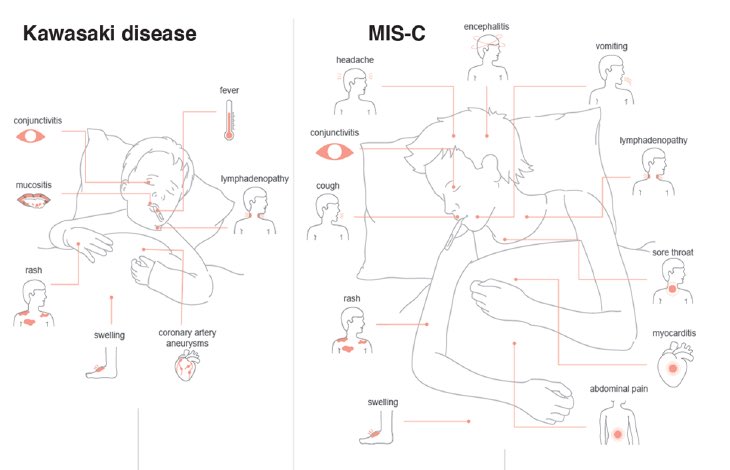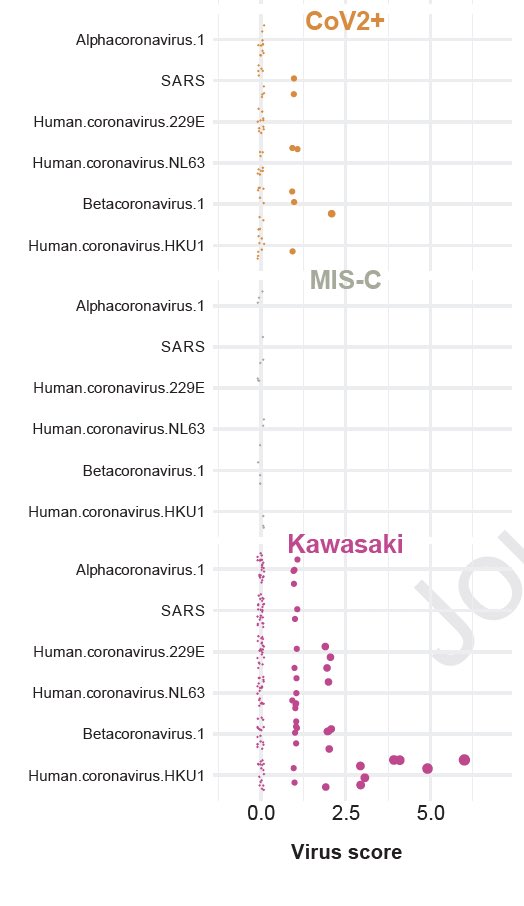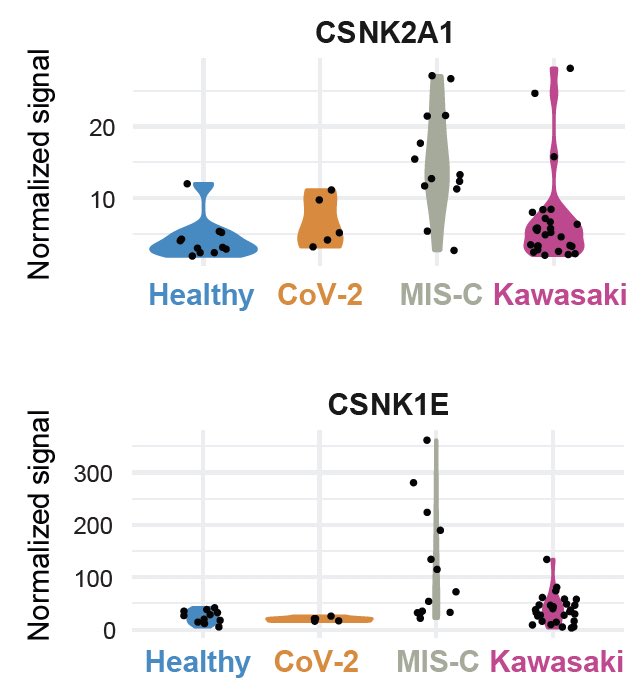An excellent new study by @BrodinPetter’s team on the differences between MIS-C and Kawasaki disease. This is incredibly timely and informative. Here are a couple of highlights. (1/)
https://www.cell.com/cell/fulltext/S0092-8674(20)31157-0">https://www.cell.com/cell/full... https://twitter.com/brodinpetter/status/1302634319345786881">https://twitter.com/brodinpet...
https://www.cell.com/cell/fulltext/S0092-8674(20)31157-0">https://www.cell.com/cell/full... https://twitter.com/brodinpetter/status/1302634319345786881">https://twitter.com/brodinpet...
While there are some common features, MIS-C and Kawasaki disease differ in important areas. Non-overlapping symptoms and organ involvement, as well as the age group affected. Age in months in this study of MIS-C patients, 106 (71.1 - 165.4), and Kawasaki 24.5 (15.8 - 41.8). (2/)
Kawasaki disease patients have much higher levels of cytokines, IL-6, IL-17A and chemokine CXCL10, than either COVID-19 or MIS-C patients. (3/)
Notably, MIS-C patients did not have antibodies to other human coronaviruses, unlike COVID or Kawasaki patients (or healthy controls). Could this hCoV-naive state contribute to MIS-C development? (4/)
The most intriguing is the comparison of autoantibodies. MIS-C patients have higher levels of antibodies to MAP2K2 and to Casein kinase family members  https://abs.twimg.com/emoji/v2/... draggable="false" alt="👇🏽" title="Rückhand Zeigefinger nach unten (mittlerer Hautton)" aria-label="Emoji: Rückhand Zeigefinger nach unten (mittlerer Hautton)"> On the other hand, Kawasaki patients had
https://abs.twimg.com/emoji/v2/... draggable="false" alt="👇🏽" title="Rückhand Zeigefinger nach unten (mittlerer Hautton)" aria-label="Emoji: Rückhand Zeigefinger nach unten (mittlerer Hautton)"> On the other hand, Kawasaki patients had  https://abs.twimg.com/emoji/v2/... draggable="false" alt="⬆️" title="Pfeil nach oben" aria-label="Emoji: Pfeil nach oben"> autoantibody against EDIL3. (5/)
https://abs.twimg.com/emoji/v2/... draggable="false" alt="⬆️" title="Pfeil nach oben" aria-label="Emoji: Pfeil nach oben"> autoantibody against EDIL3. (5/)
This study begins to unravel the pathophysiology of MIS-C. Very curious to see if the autoantibodies are found in various tissues and induce leukocyte activation or complement fixation. (End)

 Read on Twitter
Read on Twitter


 On the other hand, Kawasaki patients had https://abs.twimg.com/emoji/v2/... draggable="false" alt="⬆️" title="Pfeil nach oben" aria-label="Emoji: Pfeil nach oben"> autoantibody against EDIL3. (5/)" title="The most intriguing is the comparison of autoantibodies. MIS-C patients have higher levels of antibodies to MAP2K2 and to Casein kinase family members https://abs.twimg.com/emoji/v2/... draggable="false" alt="👇🏽" title="Rückhand Zeigefinger nach unten (mittlerer Hautton)" aria-label="Emoji: Rückhand Zeigefinger nach unten (mittlerer Hautton)"> On the other hand, Kawasaki patients had https://abs.twimg.com/emoji/v2/... draggable="false" alt="⬆️" title="Pfeil nach oben" aria-label="Emoji: Pfeil nach oben"> autoantibody against EDIL3. (5/)">
On the other hand, Kawasaki patients had https://abs.twimg.com/emoji/v2/... draggable="false" alt="⬆️" title="Pfeil nach oben" aria-label="Emoji: Pfeil nach oben"> autoantibody against EDIL3. (5/)" title="The most intriguing is the comparison of autoantibodies. MIS-C patients have higher levels of antibodies to MAP2K2 and to Casein kinase family members https://abs.twimg.com/emoji/v2/... draggable="false" alt="👇🏽" title="Rückhand Zeigefinger nach unten (mittlerer Hautton)" aria-label="Emoji: Rückhand Zeigefinger nach unten (mittlerer Hautton)"> On the other hand, Kawasaki patients had https://abs.twimg.com/emoji/v2/... draggable="false" alt="⬆️" title="Pfeil nach oben" aria-label="Emoji: Pfeil nach oben"> autoantibody against EDIL3. (5/)">
 On the other hand, Kawasaki patients had https://abs.twimg.com/emoji/v2/... draggable="false" alt="⬆️" title="Pfeil nach oben" aria-label="Emoji: Pfeil nach oben"> autoantibody against EDIL3. (5/)" title="The most intriguing is the comparison of autoantibodies. MIS-C patients have higher levels of antibodies to MAP2K2 and to Casein kinase family members https://abs.twimg.com/emoji/v2/... draggable="false" alt="👇🏽" title="Rückhand Zeigefinger nach unten (mittlerer Hautton)" aria-label="Emoji: Rückhand Zeigefinger nach unten (mittlerer Hautton)"> On the other hand, Kawasaki patients had https://abs.twimg.com/emoji/v2/... draggable="false" alt="⬆️" title="Pfeil nach oben" aria-label="Emoji: Pfeil nach oben"> autoantibody against EDIL3. (5/)">
On the other hand, Kawasaki patients had https://abs.twimg.com/emoji/v2/... draggable="false" alt="⬆️" title="Pfeil nach oben" aria-label="Emoji: Pfeil nach oben"> autoantibody against EDIL3. (5/)" title="The most intriguing is the comparison of autoantibodies. MIS-C patients have higher levels of antibodies to MAP2K2 and to Casein kinase family members https://abs.twimg.com/emoji/v2/... draggable="false" alt="👇🏽" title="Rückhand Zeigefinger nach unten (mittlerer Hautton)" aria-label="Emoji: Rückhand Zeigefinger nach unten (mittlerer Hautton)"> On the other hand, Kawasaki patients had https://abs.twimg.com/emoji/v2/... draggable="false" alt="⬆️" title="Pfeil nach oben" aria-label="Emoji: Pfeil nach oben"> autoantibody against EDIL3. (5/)">


